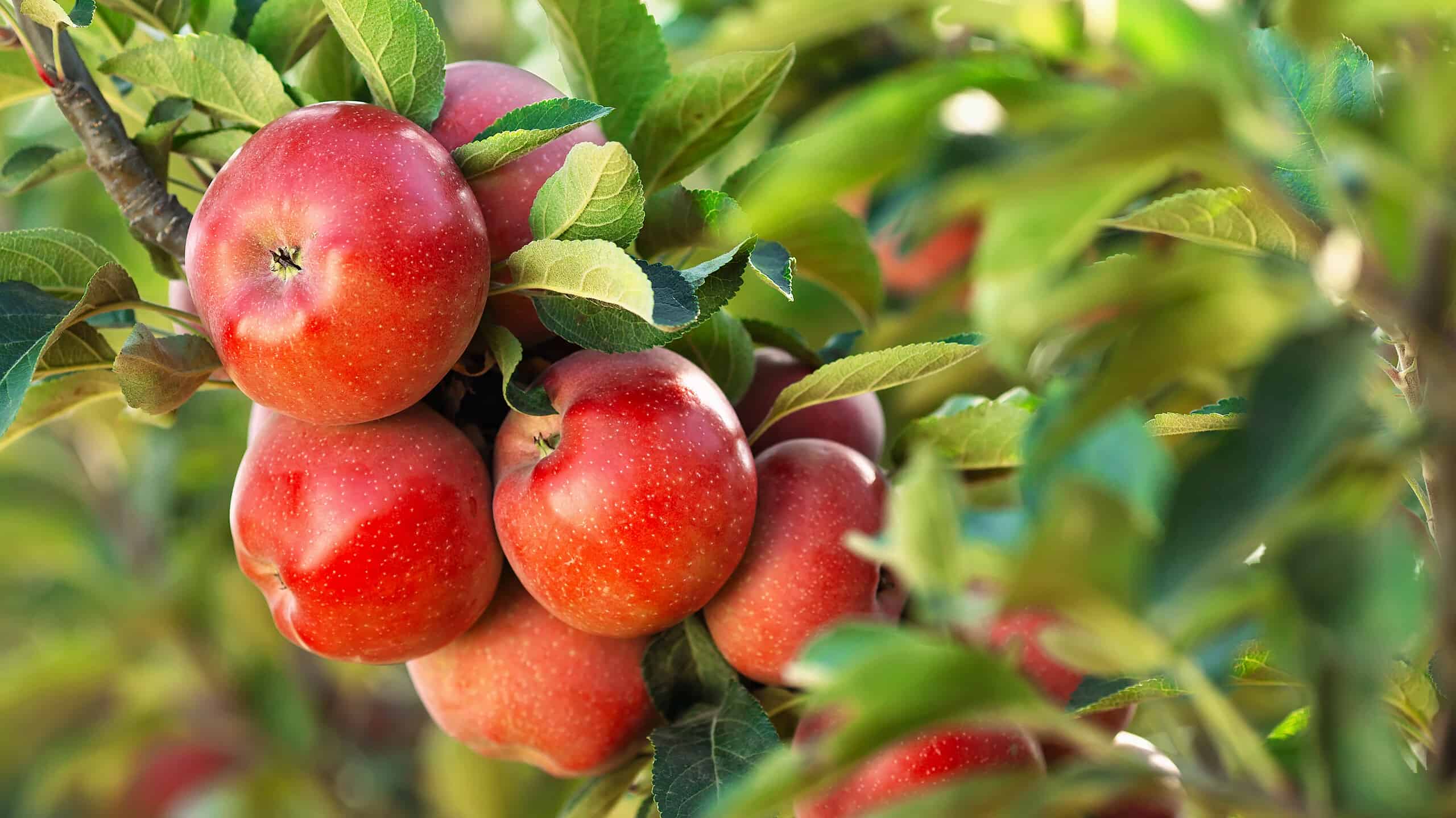Gardening can be challenging, especially when choosing suitable trees for your climate zone, and if you’re living in USDA Zone 4, you might think your options are limited. But don’t fret! This article will walk you through 12 Fruit Trees That Thrive in Zone 4. There is more variety than you may think in the fruit trees that survive and thrive in these frigid conditions.
From crisp apples to juicy plums, we’ve got you covered. So, let’s jump in and discover how you can turn your Zone 4 garden into a fruitful oasis!
What Is Zone 4?
The USDA Hardiness Zone 4 encompasses some of the chilliest and most northern regions within the contiguous United States. This zone is defined by its frosty climate, with average minimum temperatures in winter dipping between -30°F and -20°F.
Typically, the winters in Zone 4 are long and are marked by abundant snowfall. Additionally, the growing season in Zone 4 is somewhat short compared to its warmer counterparts.
List of Fruit Trees That Thrive in Zone 4
Here are some of the best fruit trees that will perform exceptionally in Zone 4.
1. Apple
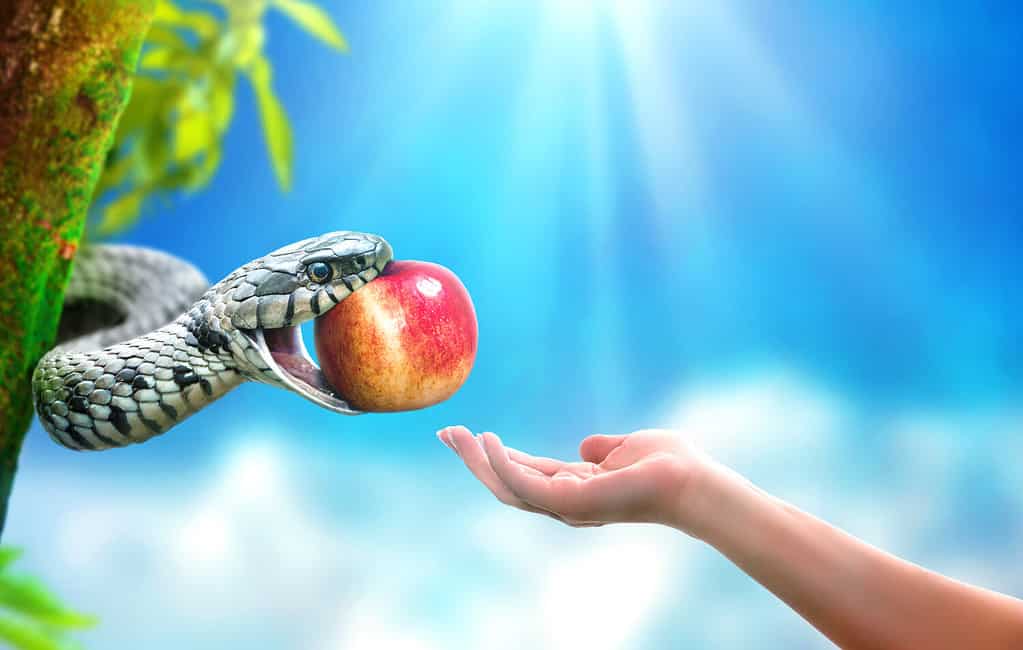
One amazing type of fruit tree for Zone 4 is the apple tree.
©funstarts33/Shutterstock.com
Apple trees stand as top contenders for successful cultivation in the chilly conditions of Zone 4. These trees can endure cold climates, an ability that is attributed to their robust rootstock – an intricate network of roots supporting an above-ground stem onto which another plant’s bud can be grafted.
Apple trees make a fantastic addition to Zone 4 orchards, potentially flourishing on a homestead for 50 to 80 years.
Noteworthy varieties for Zone 4 include Honeycrisp, Haralson, Zestar, and Golden Delicious.
The apple tree can grow to a maximum of 25 feet, both in height and in the spread of its crown.
For apple trees to grow efficiently, they require a minimum of eight hours of sunlight daily throughout the growth period. You will also need to pair two different apple varieties in order to ensure effective pollination.
While dwarf apple trees start fruiting 2 to 3 years post-planting, the standard-size trees may need up to 8 years to bear fruit.
2. Pear

There are several varieties of pear fruit trees that can survive in Zone 4.
For Zone 4, pears make an excellent choice, with several pear tree variants demonstrating resilience to the extreme cold.
The Early Gold variety, for instance, is not only sturdy enough for Zone 4 but also suitable for the colder Zone 3. Other examples of pear trees that perform well in Zone 4 include Golden Spice and Gourmet.
These cold-resistant trees exhibit a conical form in their youthful stage, which gradually morphs into a round shape as they mature. Most pear tree species typically reach a height of about 40 feet and spread their canopy roughly 30 feet wide.
Pears thrive in moisture-rich but well-draining soils and prefer full sun to partial shade. Regular pruning is recommended – for fan- and espalier-trained pears in summer and for standard pears in winter.
As for fruit-bearing, pear trees need a bit of patience. They typically start yielding fruit anywhere from 3 to 7 years old, with the exact timing depending largely on the tree’s size and variety.
3. Cherry
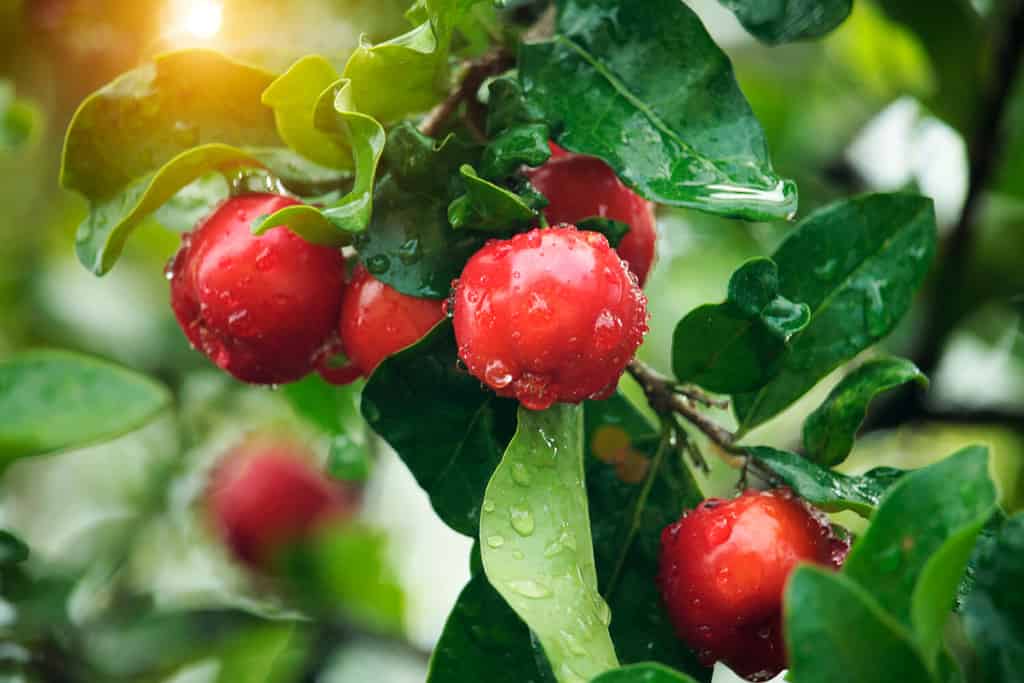
Cherries are a delicious fruit that you can grow in cold weather climates.
©Mr.Somchai Sukkasem/Shutterstock.com
When looking to plant a cherry tree in Zone 4, it’s a smart move to opt for a variety known for its cold resistance right from the outset. Luckily, a handful of cherry tree varieties are well-suited to colder climes. One such variety is the Rainier, a semi-dwarf cherry tree reaching up to 25 feet tall.
If tart cherries are more to your liking, Early Richmond is a prolific cherry tree for Zone 4. This tree’s abundant fruit — maturing a week earlier than other tart cherries — is visually appealing and ideal for baking into pies or transforming into jams.
Another Zone 4-hardy variety is the “Sweet Cherry Pie” cherry tree. This compact tree is assuredly capable of withstanding Zone 4 winters, even proving successful in the colder Zone 3.
On average, cherry trees take about three years to establish and may start producing fruit in their fourth year.
When planting cherry trees pick locations with south-facing slopes that receive full sun and are sheltered from wind. Ensure the chosen soil offers superior drainage.
4. Plum
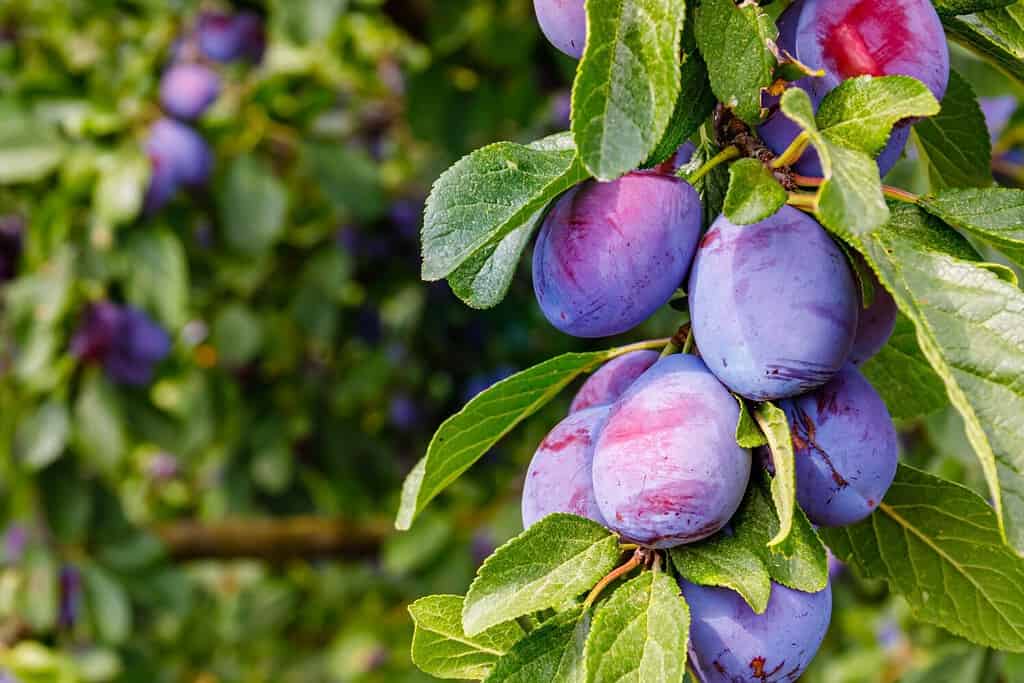
Another delicious and hardy fruit tree is the plum tree.
©nnattalli/Shutterstock.com
Plum trees display remarkable hardiness, with several species ideally suited to USDA Zone 4. Here are some varieties of plum trees that will thrive in your Zone 4 garden.
The Toka plum, in existence since the early 20th century, is an attractive variety sometimes referred to as ‘bubblegum plums’ thanks to its unique aroma and sweet taste. The Lydecker, or black ice plum, can withstand temperatures as low as -30°F, offering peace of mind during intense winter frosts. The Superior plum tree, an adaptable and highly cold-resistant variety, is a natural hybrid of Japanese and American plums.
In general, plum trees are compact in nature, typically reaching a maximum height of around 16 feet and a breadth of approximately 13 feet.
Plum trees usually start to yield fruit when they’re between three and six years old. Some varieties may begin to produce small fruits even earlier.
Cultivating plum trees isn’t very complicated, provided their basic needs are met. These trees prefer full sun exposure and thrive in well-drained, sandy soil.
5. Apricot
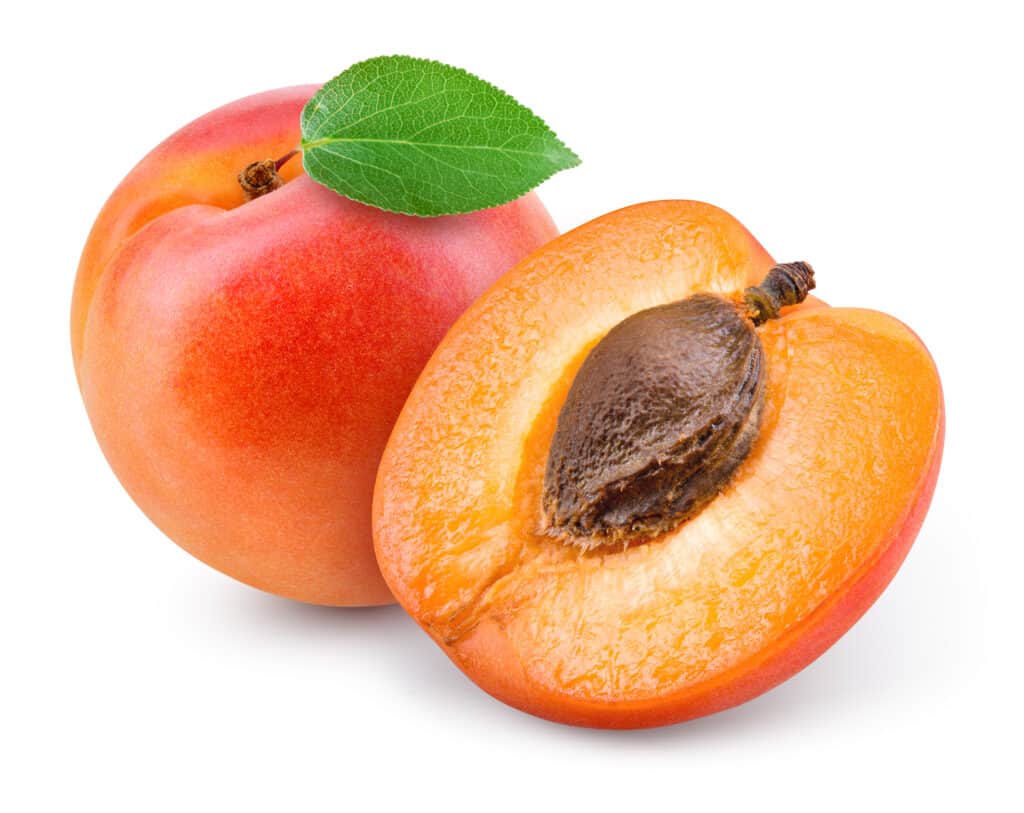
Surprisingly, certain types of apricots can grow in Zone 4.
©Tim UR/Shutterstock.com
Although apricot trees tend to prosper in the sun-drenched, temperate climes of California with its warm days and cool nights, some varieties can also produce fruits in Zone 4.
Apricot trees blossom in the latter part of winter and early spring, so opting for a cold-resistant variety such as the Westcot or Scout can yield fruitful results. If you decide on a cold-resistant tree, make sure to research whether your tree needs another apricot tree close by for successful pollination.
Typically, standard trees reach heights and widths of 20 to 25 feet. Apricot trees usually start producing their initial fruits 2-3 years after being planted in their permanent location, but it takes around 4-5 years for them to yield a full harvest.
Before planting your new tree, carefully examine your yard to identify the perfect spot. Choose a location that gets at least six to eight hours of sunlight each day. The soil should be loose, fertile, and offer good drainage, ideally with a pH level between 6.0 and 7.0.
6. Peach

Think you can’t grow your own peaches in Zone 4? Actually, there are a couple of varieties of peach trees that can thrive in the cold.
©Crisp0022/Shutterstock.com
It may surprise some because peaches from Georgia and Florida are super popular. But peach trees can indeed flourish in northern gardens. The most resilient types can withstand chilling temperatures down to -20 degrees F.
Among the most favored for colder climates is the Contender, known for its large, firm, and high-quality fruits. The Reliance peach tree is another great option for Zone 4 gardeners, esteemed for its impressive hardiness. The Blushingstar peach tree is also a charm with its attractive, pink-red peaches that taste as good as they look.
If left untouched, a peach tree can grow to be as tall as 25 feet and almost as wide. Given suitable growing conditions and appropriate care, peach trees will start producing fruit within 2-4 years.
For successful peach cultivation in Zone 4, it’s important to plant the trees in a location that stays cold during early spring. The ideal spot would have some shade and abundant snow cover in the spring but receive plenty of sunlight in the summer.
7. Nectarine
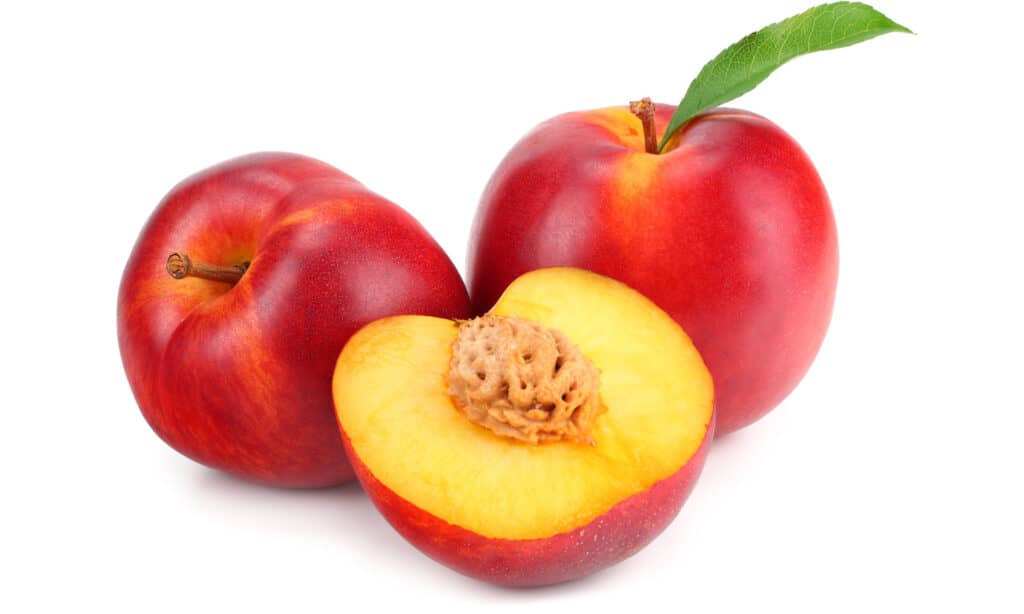
With a bit of extra care, hardy varieties of nectarine trees can grow in Zone 4.
©iStock.com/Dmytro
Most nectarine trees typically grow in USDA hardiness Zones 6 to 8; however, newer varieties have been cultivated that can grow in colder climates, such as Zone 4. Still, you may need to provide additional protection during the winter months when growing these trees.
The Stark HoneyGlo miniature nectarine is a variety that can adapt well to Zones 4 through 8, and it has the flexibility to be cultivated in an 18- to 24-inch container. ‘Intrepid’ is another nectarine variety that can withstand the conditions in Zones 4 to 7. Known for its large, firm freestone fruits with sweet flesh, it can handle temperatures as low as -20 F.
Nectarine trees can reach heights between 15 and 20 feet. Most nectarine trees start producing fruit when they are 2-3 years old
Newly planted nectarine trees lack sufficient frost resistance and must be safeguarded from the winter chill. Select a location that gets plenty of sunlight, is sheltered from harsh weather, and has fertile, well-drained soil.
8. Currants
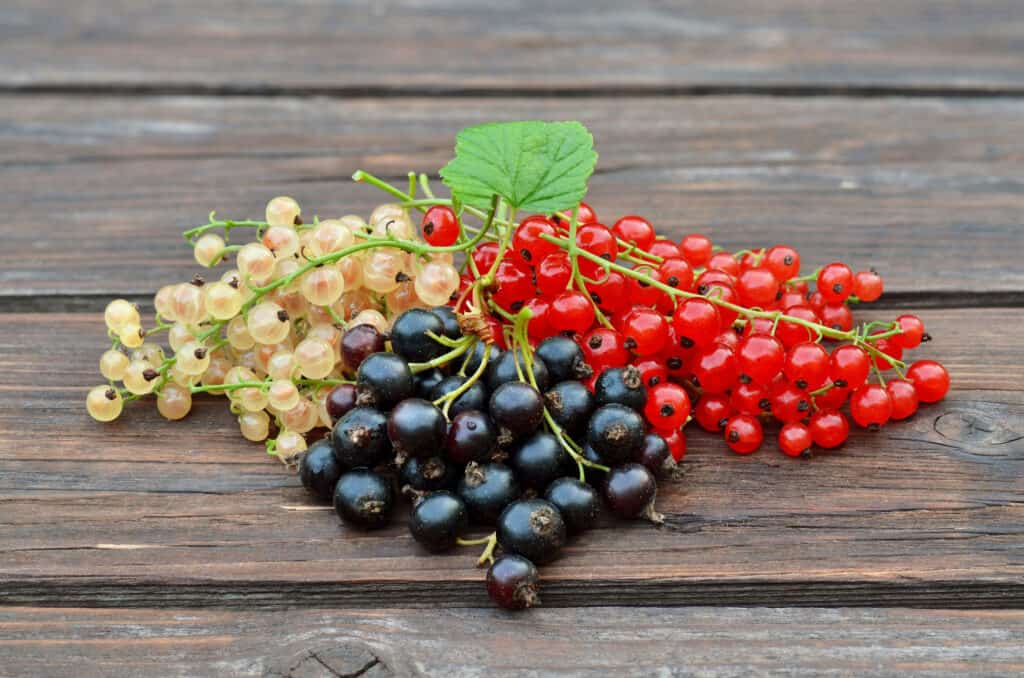
Commonly dried or used in juices, currants are an excellent berry for cold climates.
©iStock.com/Yuliia Bilousova
Currants, often mistaken for blueberries due to their small, round shape, grow on thornless shrubs. They’re resilient and can flourish in USDA hardiness Zones 3 to 8, with some variants being cold-tolerant up to Zone 2. These shrubs can reach a height and spread of 3 to 6 feet.
For those in Zone 4, consider varieties such as Rovada and Honeyqueen. Rovada is particularly robust and late-blooming, which allows it to avoid frosts. It yields large, aromatic berries in long clusters. On the other hand, Honeyqueen offers a lengthy harvest period of soft, juicy fruits that have an appealing taste.
Currants thrive in both sunny and partially shaded spots. They require soil that drains well, is enriched with organic matter, and has a pH level between 5.5 and 7.0. If you have clay or sandy soil, mix in ample organic matter before planting, or use a raised bed for planting.
The advantage of currants is that they bear fruit relatively quickly – you can expect large, high-quality berries within three years of planting.
9. Hardy Kiwi

While normal kiwi fruit requires a warmer climate, hardy kiwi fruit can grow in zone 4.
©photobeps/Shutterstock.com
For those residing in cooler climates of USDA Zone 4, consider growing hardy kiwi, a more resilient variant of the usual kiwi fruit. These hardy kiwi, often referred to as kiwi berries due to their smaller size, grow in bunches on the vine and offer a taste similar to their larger, fuzzy, and less cold-resistant counterpart.
Specific varieties suitable for Zone 4 include Actinidia kolomikta and Actinidia arguta. Remember that you need both male and female kiwi vines for successful fruit production – only the female vines bear fruit, and male vines are essential for pollination. For every group of one to nine female kiwi plants, ensure you have one male kiwi plant.
These vines can reach a length of 10 to 30 feet. They thrive in full or partial sunlight and prefer loamy and well-drained soil with an acidic pH.
How quickly you see fruit depends on the kiwi vine’s variety and its age at the time of planting. You can generally expect fruit to appear between 2 and 5 years.
10. Quince

Quince fruits are similar to pears but are more commonly eaten cooked than raw.
©darksoul72/Shutterstock.com
The quince tree is known for its fragrant golden-yellow fruit that resembles a pear. Specifically, the Crimea variety of quince is resilient to the colder climates of USDA Zone 4.
While the quince fruit is entirely edible, it has a notably bitter taste when raw. However, this tartness transforms into a pleasing sweetness when the fruit is cooked. The quince trees, growing independently, can reach heights and widths between 13 to 16 feet.
When grown from seeds, quince trees typically start bearing fruit within five years.
Although quince trees show some resilience to dry conditions, ensure you water them during extended periods of drought as part of your regular care routine. Overwatering is not a concern with quince trees, so when in doubt, it’s better to water them. While they thrive best in full sunlight, ensuring optimum bloom and fruit production and helping avoid diseases, quince trees can also tolerate some degree of partial shade.
11. Fig
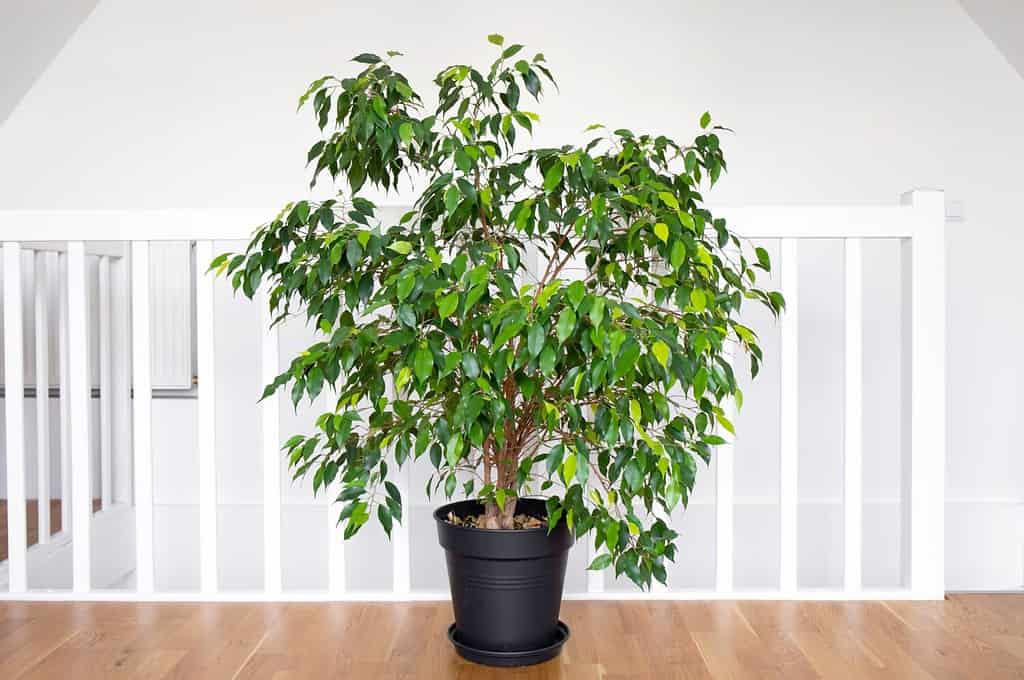
When growing figs in Zone 4 you should plant them in portable pots that can be taken inside during the coldest days.
©FotoHelin/Shutterstock.com
In the northern areas, even as far as Zone 5 or sometimes Zone 4, figs can be grown with the help of protective measures, depending on the exact location of planting.
Figs hold a unique position on this list of being adaptable both indoors and outdoors. While they can prosper outdoors, many gardeners prefer to grow them in pots. This enables easy transitioning – keeping them outdoors during the warm summer months and moving them indoors following the first frost of the year.
The Hardy Chicago variety is known as the most frost-resistant fig.
Full-grown fig trees can range from 15 to 30 feet in height. On average, a fig tree will start producing ripening fruit between three to five years.
Two key elements are necessary for fig trees to thrive: ample sunlight and sufficient space. Choose a location that receives at least six hours of sunlight daily. In chillier regions, to help figs withstand the winter, plant them in a spot with southern exposure or near a south-facing wall that can absorb and retain warmth.
12. Serviceberry
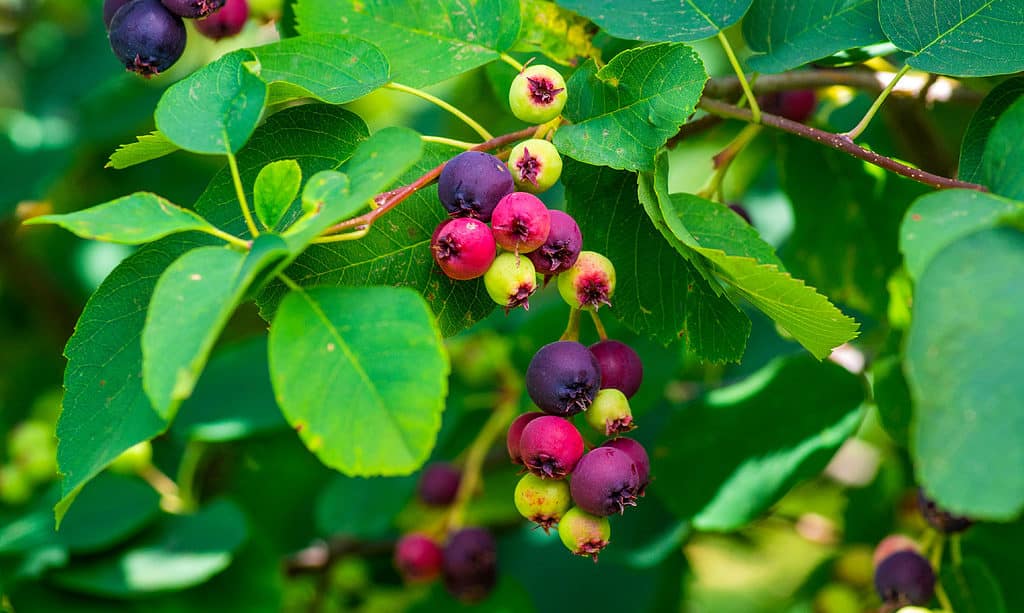
The serviceberry tree can grow very well in the cold temperatures of USDA Zone 4.
©Iva Vagnerova/Shutterstock.com
Serviceberries not only offer a delightful taste but are also packed with nutrients. These trees, which can grow anywhere between 6 to 20 feet tall or even higher upon maturity, are suitable for a wide range of USDA growing zones, from 2 to 9, making them an excellent option for Zone 4.
The Downy, also known as Common Serviceberry, is a top choice for cultivation in Zone 4. This tree produces small red fruits that mature in June, becoming a much-loved treat for birds. Its attractive, smooth, gray bark features distinctive vertical stripes.
The serviceberry tree starts to yield heavier crops when it’s 3-5 years old, reaching full production capacity at around 8 years.
Lighter soils, as opposed to those heavy in clay, are more conducive to their growth due to better drainage capabilities. While serviceberries can grow in partial shade and full sun, a spot with maximum sun exposure is suggested for the most substantial and tastiest fruit harvest.
Summary of Fruit Trees That Thrive in Zone 4
| Fruit Tree | Growth Rate |
|---|---|
| Apple | Medium to fast |
| Pear | Fast |
| Cherry | Very fast |
| Plum | Medium |
| Apricot | Fast |
| Peach | Medium to fast |
| Nectarine | Fast |
| Currants | Fast |
| Hardy Kiwi | Fast |
| Quince | Slow to medium |
| Fig | Medium |
| Serviceberry | Medium |
Please note that successful growth also depends on specific local conditions, such as soil type, exposure to sun and wind, and the specific variety of the tree. It’s always a good idea to consult with a local extension service or nursery for the best advice on choosing fruit trees for your specific location.
Thank you for reading! Have some feedback for us? Contact the AZ Animals editorial team.

